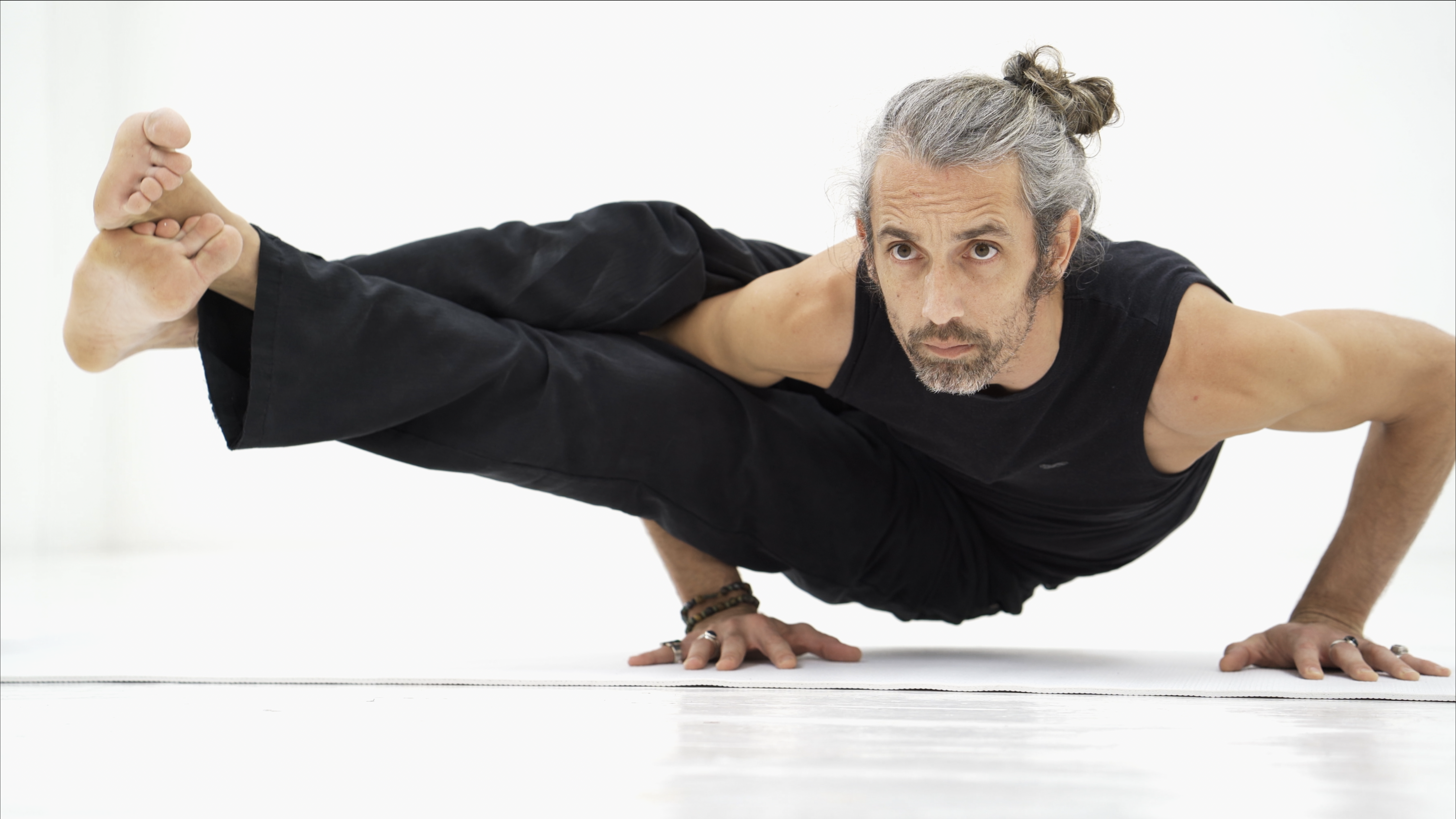
by Calum Thomson
Yoga is a philosophy of life. It is a highly regarded, powerfully life changing and life enhancing experiential practice.
This article is to explain specifically that which is the practice of Ashtanga Vinyasa Yoga
Ashtanga Yoga is the path outlined in Patanjali’s yoga sutras, a classical yoga text for the beginner practitioner of Yoga. It refers to the eight branches or the eight “Limbs” of Yoga.
“Ashtanga” literally means eight limbs. They are described by Patanjali as: Yama (abstinences), Niyama (observances), Asana (postures), Pranayama (breath control), Pratyahara (sense withdrawal), Dharana (concentration), Dhyana (meditation), and Samadhi (contemplation).
YAMA
Yamas are the moral restrictions of the external kind. “YAMA” translates as control or restraint and is broken down into five external disciplines of how one should act in the world around them. They are: ahimsa (non-harming), satya (truthfulness), asteya (non-theft), brahmacharya (control of the sexual energy), and aparigraha (greedlessness)
NIYAMA
These are moral restrictions of the internal kind. “NIYAMA” means “moral restraint” or “discipline” and is also broken down into five, not external but internal, disciplines. They are; saucha (purity); santosha (contentment); tapas (asceticism); svadhyaya (spiritual study); and ishvarapranidhana (devotion to God)
ASANA
The physical postures of the yoga practice. This limb is to keep the physical body strong and supple giving the individual the ability to sit in meditation for long periods of time with the goal of obtaining Samadhi, Nirvana or enlightenment.
Sutra 2.46 in the classical text of Patanjali states that posture should be obtained with “comfort and ease”
स्थिरसुखमासनम् ॥४६॥
sthira-sukham-āsanam ॥46॥
PRANAYAMA
Pranayama is the control of “Vital life force” (breath). It is the regulation and control of energy through the breath. “pranayama” means “awareness and extension of prana.”
When an individual has mastered the physical postures in the Asana limb they are ready to practice that of breath control. Pranayama is more than mere breathing exercises, as it requires constant awareness and concentration
PRATYAHARA
Pratyahara is the withdrawal of the senses. With pratyahara, we learn to develop control over the senses.
DHARANA
Dharana is single pointed concentration. This limb is one of the internal stages. In the mastering of this limb the concentration of the individual can be inward or outward and the practice can be performed with the eyes open or closed.
The obtainment of this limb is complete absorption in a single point of focus. Without single-pointed focus, we will never gain control over the mind and we will find it impossible to maintain long periods of mental stillness to reach Dhyana and Samadhi
DHYANA
Dhyana is the practice of deep meditation. This is where the mind has now become one pointed and completely focused. At first, individuals will find that this state can only be reached or maintained in short bursts or periods of time but the more they practice this state of being the longer and more easily this state can be maintained.
SAMADHI
A state in which the meditator and meditation become one. A place of liberation has been obtained and Yoga has been achieved.
Before an individual takes up the physical practice through asana, like all the eight limbs of the Patanjali system they should be practiced and mastered in order, individuals should first be practicing and mastering correct external and internal conducts – that of their Yama’s and Niyama’s.
What is Vinyasa?
“Vinyasa” is breath-synchronized movement. Regulated breathing and movement between poses. It’s the linking of one asana to the next. “Vinyasa” is derived from the Sanskrit term nyasa, which means “to place,” and the prefix vi, “in a special way”.
What is Ashtanga Vinyasa Yoga?
It is often referenced as the modern day form of classical yoga. Ashtanga vinyasa is a particular style of yoga systemised and popularised by Sri. K Pattabhi Jois.
Although he himself claimed to of learnt the Ashtanga series from Tirumalai Krishnamacharya who guided him to a text called the Yoga Korunta authored by Vamana Rishi 5000 years ago (although the last surviving copy purportedly was eaten by ants) there are other theories that it derived from a Swedish gymnastic influence. This is supported by the fact that pre 20th Century yoga texts only include the asana Padmasana or variants of this particular pose.
Ashtanga Vinyasa is a postural yoga practice which synchronises breath and movement in a flowing sequence of asanas (postures).
Each asana has a set number of breaths/movements in and out of the pose and a number of breaths whilst in the pose, – usually 5. Whilst breathing, both the inhale and exhale are ideally even and steady.
There are 6 series in the Ashtanga yoga system with each one of the series practiced with a different intent.
The Primary series
Yoga Chikitsa
The intent being to provide the practitioner with an overall yoga therapy for health. This series is in Sanskrit traditionally referred to as Yoga Chikitsa.
The Primary Series is a complete practice that can help you heal your body and mind. Most individuals never progress beyond the Primary series of Ashtanga vinyasa as this series within itself is extremely challenging.
The Intermediate series
Nadi Shodhana
The second series of the Ashtanga yoga system is the Nerve purifier
This series in Sanskrit traditionally is referred to as Nadi Shodhana.
The Advanced series:
Sthira Bhaga
Advanced A (Third series)
Advanced B (Fourth series)
Advanced C (Fifth series)
Advanced D (Sixth series)
When practiced correctly, with intention, focus, discipline and perseverance it cleanses, purifies, brings clarity to individuals minds as well as strengthening and flexibility, not only in the physical, but mental and emotional bodies too.
The practice of Ashtanga yoga is traditionally practiced six days a week each morning. It begins with five rounds of Surya Namaskar A followed by five Surya Namaskar B followed by a series of standing postures. It is here that the sequence changes to adapt to one of the six series an individual is working towards mastering until finally reaching and ending each series again with the same finishing postures.
Ashtanga Yoga places emphasis in its system on three main components being breath; posture and drishti. This is named the Tristhana of Ashtanga Vinyasa.
Ashtanga Vinyasa Tristhana
Tristhana translates to three places of attention of action. These three components are the very core of the Ashtanga Yoga practice. When an individual practices this system interweaving these three core points of action they are able to gain control of the senses, cultivate a deep awareness of self by activating three levels of purification: the body, the nervous system and the mind.
Pranayama
Ujjayi Pranayama – correct breathing.
Asana
Postures
Drishti
Point of focus or gazing point
An additional component is also given emphasis in this system, that of the Bandhas.
Bandhas
Bandhas are a psychosomatic energy locks within the body. The reason I call these psychosomatic is If you were to cut open a human body you would not find a Bandha in the same way you would find a tendon, ligament or any other physical internal body part.
There are three main internal body locks…
Mula Bandha – A root lock at the pelvic floor, this is where one draws in the perineum. In a yoga class it is often described as holding in the need to pee.
Uddiyana Bandha – This is a drawing inward of the stomach around two inches from the bottom of the navel.
Jalandhara Bandha – This is the internal throat lock, this is obtained by lowering the chin slightly while raising the sternum upwards.
Sharath Jois, Pattabhi Jois’s grandson states, “Without bandhas, breathing will not be correct, and the asanas will give no benefit”
Over the last few decades, like many other traditional styles of yoga the original practices have morphed from their traditional roots into more new age styles. When it comes to Ashtanga Vinyasa it is Power yoga which began in the 1990’s by practitioners who originally trained under Sri K. Pattabhi Jois that have become progressively popular however many educated, dedicated and passionate teachers express their disappointment in the status in which these new styles of Yoga have made in their own right.
To make the Ashtanga vinyasa set sequences more accessible to a wider range of practitioners, many teachers have since adapted the system to accommodate individuals needs and varied abilities. This being with short form sequences and a more relaxed, accommodating attitude towards a once heavily strict practice.
Overall in the practice of any system of Yoga if there is no effort there is no benefit. There are so many life enhancing qualities required and obtained through any one of the practices and styles of Yoga. For me, working through the Ashtanga Vinyasa series is my chosen style that suits my character, personality and goal.
If you would like to learn more about Ashtanga Vinyasa Yoga you are welcome to join my lead classes on a Thursday morning or a Sunday afternoon.
